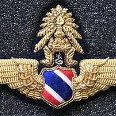Civil Aviation Training Center Thailand Told To Produce More Pilots In Preparation For AEC
-
Recently Browsing 0 members
- No registered users viewing this page.
-
Topics
-
-
Popular Contributors
-
-
Latest posts...
-
0
Another Wise observation
New for me so just for information. I have scheduled transfers from Wise (3000 EUR) to BKK bank account on 27th each month. Normally money would be sent around 07:30 and be in my BKK bank account around 14:00 same day. Today was instant. Arrived 07:30 in my BKK bank account. BKK bank code changed from Internation Funds Transfer to DEP TRF FR E-CH. (Deposit Transfer From Electronic-Channel) -
10
Community Pattaya Ambulances Banned From Running Red Lights
I was thinking exactly the same thing. Typical for Thais to impose disastrous consequences to the wrong thing. Simply because one time an accident happened. I am inclined also to believe that accident that happened causing this was because the previous ambulance crossed the intersection with lights and sirens and the other car failed to yield. Either way, it does not make a difference if that was the case. Ambulances have the right of way but in Thailand when people see and hear them. They either do nothing to make room or they use the ambulance to get through the traffic faster by staying close behind it. Stopping and waiting for a red light. could mean the death of the person inside who urgently needs to get to the hospital. But, i doubt we will be seeing news like that now after this action. -
135
Americans seek escape for political reasons at record numbers
Step away from your BS meter and have another look. You being close to it likely pegging it. Sure, Trump could be dying, and his medical staff could be lying. That would no surprise me. But so what? It really changes nothing, he’s still president. -
4
Pls Settle Debate On Kite Flying
Not the same action at all. We used Translate and kite flying definitely came up as a verb (of course). There were other words, but this we agreed was the best choice from Translate -
7
UK-Asylum crisis Nigel Farage says illegal migration is a 'scourge'
Yes I do. And it’s irrelevant to the subject of this thread. -
7
SIM provider new passport
I did this a few weeks ago. I usually take everything: yellow house book, wife's blue house book, wife's Thai ID card, Thai ID, passport, driver's licence etc. They just give me back what they don't need. When you give True your passport they will enter the details into the system and give you a new SIM card with your old phone number or new one if you change it. If you are with Kasikorn bank you need a copy of the paper where they linked your SIM to your pp number to show your bank. Bankok bank didn't require the copy. Took me about half an hour, but it depends on how busy the True outlet is.
-
-
Popular in The Pub










Recommended Posts
Create an account or sign in to comment
You need to be a member in order to leave a comment
Create an account
Sign up for a new account in our community. It's easy!
Register a new accountSign in
Already have an account? Sign in here.
Sign In Now